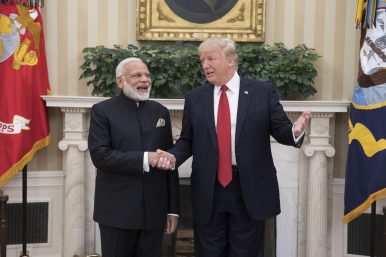By Aman Thakker
 The Trump administration’s decision to withdraw India’s Generalized System of Preferences (GSP) benefits not only risks adversely affecting the broader strategic relationship with India, but also giving a boost to Chinese exports.
The Trump administration’s decision to withdraw India’s Generalized System of Preferences (GSP) benefits not only risks adversely affecting the broader strategic relationship with India, but also giving a boost to Chinese exports.
On March 4, 2019, President Donald Trump wrote a letter to Congress to provide notice of his intent to terminate the designation of India as a beneficiary country under the Generalized System of Preferences, a program designed to “promote economic growth and development in the developing world.” Although the Indian government noted that the “GSP concessions extended by the U.S. amounted to duty reduction of only $190 million” per year, this decision could spill over and adversely affect other aspects of the U.S.-India relationship. Moreover, by revoking India’s GSP benefits, the Trump administration may also worsen America’s trade deficit with other countries, notably China.
Risks to the U.S.-India Relationship
The decision to revoke India’s GSP benefits was a culmination of a decision by the Office of the United States Trade Representative to initiate a review of India’s eligibility for the program in April 2018. The key factors for the review were unfavorable market access for U.S. dairy and medical devices. Over the next 10 months, as both countries attempted to negotiate a mutually agreeable trade deal, other issues such as Indian local content rules, price controls, rules mandating data localization, and changes to FDI rules regarding e-commerce became crucial parts of the agenda.
However, the policy dispute overlooked the fact that U.S.-India trade was booming over the past year. Total goods trade grew 16.7 percent between December 2017 and November 2018, with U.S. exports to India growing at 27 percent during the same timeframe. Revoking GSP at this juncture risks threatening this growth in trade. India has been postponing retaliatory tariffs to U.S. tariffs on steel and aluminum imports in hopes of reaching a favorable agreement with the United States. While India’s commerce secretary has said that New Delhi will keep these retaliatory tariffs out of discussions with the United States following the decision to revoke India’s GSP benefits, that may still change in the future and threaten this fast-growing trade relationship.
The United States and India have also taken strides to advance their broader relationship. India signed the Communication, Compatibility, and Security Agreement (COMCASA) in September 2018, and the United States has outlined a central role for India as part of its new “Free and Open Indo-Pacific” strategy. With steady, continued progress in the defense relationship, both countries will need to be careful that the trade dispute does not spill over into these other aspects of the relationship.
Benefits for Chinese Goods
The decision to withdraw GSP benefits to India also creates opportunities for China, which maintains a trade surplus with both India and the United States, to expand its exports to the United States. In response to the decision by USTR to initiate reviews of India’s eligibility under the GSP program, several members of India’s business communities warned that Chinese goods would benefit if GSP benefits for India are revoked. For example, the Federation of Indian Chambers of Commerce and Industry argued that “by removing the GSP benefits availed by India, the exports to the United States from India could potentially be replaced by China.”
Several specific products, such as bulk industrial bags, footwear, and plastics are likely to become less competitive against Chinese products without the GSP benefits. Umesh Anandani, secretary general of the Indian Flexible Intermediate Bulk Containers Association wrote that “India and China are the two major suppliers of these FIBC bags to the USA, commanding an almost equal share of the market.” Without GSP benefits, exported industrial bags will become less competitive vis-à-vis China, allowing the Chinese to increase their market share.
Similarly, Nate Herman, senior vice president at the American Apparel & Footwear Association argued that “Until GSP, China alone controlled 85 percent of all U.S. travel goods imports,” adding that “If GSP benefits are withdrawn for India, Indonesia, and Thailand, companies will have no choice but to return to sourcing from China.” This argument underscores just how beneficial this decision to revoke GSP benefits for India is for Chinese goods, which only conflicts with Trump’s goal to reduce the trade deficit with China and make trade with it fairer.
Trade tensions between the United States and India have risen to a new level following Trump’s decision to notify his intent to terminate India’s designation of India as a GSP beneficiary country. While both countries have taken strides to strengthen their relationship in recent years, the revocation of GSP benefits for India could spill over and negatively impact the broader relationship. And trade diversion away from India could worsen U.S. trade deficits with other nations, further fueling the Trump administration’s concerns about global trade flows.
Aman Thakker is a Research Associate at the Wadhwani Chair in U.S.-India Policy Studies at CSIS and a Contributor for The Diplomat.
No comments:
Post a Comment